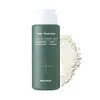What's inside
What's inside
 Key Ingredients
Key Ingredients

 Benefits
Benefits

 Concerns
Concerns

 Ingredients Side-by-side
Ingredients Side-by-side

Water
Skin ConditioningSodium Lauroyl Methyl Isethionate
CleansingGlycerin
HumectantDecyl Glucoside
CleansingCocamidopropyl Betaine
CleansingSodium PEG-7 Olive Oil Carboxylate
EmulsifyingFerulic Acid
AntimicrobialSodium Methyl Oleoyl Taurate
CleansingLauryl Glucoside
CleansingCoco-Glucoside
CleansingHypochlorous Acid
AntiseborrhoeicPhenoxyethanol
PreservativePanicum Miliaceum Seed Extract
Skin ConditioningSqualane
EmollientSodium Hyaluronate
HumectantPelargonium Graveolens Flower Oil
MaskingEthylhexylglycerin
Skin ConditioningCitrus Aurantium Bergamia Fruit Oil
MaskingLactobacillus Ferment
Skin ConditioningSodium Benzoate
MaskingCitrus Limon Peel Extract
EmollientLactic Acid
BufferingCitric Acid
BufferingMalic Acid
BufferingPropylene Glycol
HumectantPotassium Sorbate
PreservativeSolanum Lycopersicum Fruit Extract
AntioxidantVaccinium Myrtillus Leaf Extract
AstringentWater, Sodium Lauroyl Methyl Isethionate, Glycerin, Decyl Glucoside, Cocamidopropyl Betaine, Sodium PEG-7 Olive Oil Carboxylate, Ferulic Acid, Sodium Methyl Oleoyl Taurate, Lauryl Glucoside, Coco-Glucoside, Hypochlorous Acid, Phenoxyethanol, Panicum Miliaceum Seed Extract, Squalane, Sodium Hyaluronate, Pelargonium Graveolens Flower Oil, Ethylhexylglycerin, Citrus Aurantium Bergamia Fruit Oil, Lactobacillus Ferment, Sodium Benzoate, Citrus Limon Peel Extract, Lactic Acid, Citric Acid, Malic Acid, Propylene Glycol, Potassium Sorbate, Solanum Lycopersicum Fruit Extract, Vaccinium Myrtillus Leaf Extract
Zea Mays Starch
AbsorbentSodium Cocoyl Glycinate
CleansingPotassium Myristate
EmulsifyingPullulan
Sodium Polyacrylate
AbsorbentBetaine
HumectantMelaleuca Alternifolia Leaf Oil
AntioxidantChromium Oxide Greens
Mannitol
HumectantPapain
Skin ConditioningWater
Skin ConditioningBromelain
Skin Conditioning4-Terpineol
MaskingGlycerin
HumectantLactobacillus Ferment
Skin ConditioningMelaleuca Alternifolia Leaf Water
Antimicrobial1,2-Hexanediol
Skin ConditioningButylene Glycol
HumectantMelaleuca Alternifolia Leaf Extract
PerfumingGlycine
BufferingGlutamic Acid
HumectantAspartic Acid
MaskingSodium Chloride
MaskingHistidine
HumectantSerine
MaskingArginine
MaskingThreonine
Alanine
MaskingProline
Skin ConditioningAcrylates/C10-30 Alkyl Acrylate Crosspolymer
Emulsion StabilisingMagnesium Chloride
Calcium Chloride
AstringentZea Mays Starch, Sodium Cocoyl Glycinate, Potassium Myristate, Pullulan, Sodium Polyacrylate, Betaine, Melaleuca Alternifolia Leaf Oil, Chromium Oxide Greens, Mannitol, Papain, Water, Bromelain, 4-Terpineol, Glycerin, Lactobacillus Ferment, Melaleuca Alternifolia Leaf Water, 1,2-Hexanediol, Butylene Glycol, Melaleuca Alternifolia Leaf Extract, Glycine, Glutamic Acid, Aspartic Acid, Sodium Chloride, Histidine, Serine, Arginine, Threonine, Alanine, Proline, Acrylates/C10-30 Alkyl Acrylate Crosspolymer, Magnesium Chloride, Calcium Chloride
Ingredients Explained
These ingredients are found in both products.
Ingredients higher up in an ingredient list are typically present in a larger amount.
Glycerin is already naturally found in your skin. It helps moisturize and protect your skin.
A study from 2016 found glycerin to be more effective as a humectant than AHAs and hyaluronic acid.
As a humectant, it helps the skin stay hydrated by pulling moisture to your skin. The low molecular weight of glycerin allows it to pull moisture into the deeper layers of your skin.
Hydrated skin improves your skin barrier; Your skin barrier helps protect against irritants and bacteria.
Glycerin has also been found to have antimicrobial and antiviral properties. Due to these properties, glycerin is often used in wound and burn treatments.
In cosmetics, glycerin is usually derived from plants such as soybean or palm. However, it can also be sourced from animals, such as tallow or animal fat.
This ingredient is organic, colorless, odorless, and non-toxic.
Glycerin is the name for this ingredient in American English. British English uses Glycerol/Glycerine.
Learn more about GlycerinLactobacillus Ferment is created by fermenting the Lactobacillus bacteria. It helps keep our skin's natural barrier and microbiome healthy.
Studies show lactobacillus ferment to be effective at repairing the skin barrier. Having a healthy skin barrier helps keep your skin healthy and hydrated. It also protects against bad bacteria.
As a probiotic/prebiotic/postbiotic, Lactobacillus ferment can help regular our natural biome. In fact, one study found a lack of diversity in our natural skin biome can trigger acne.
Learn more about Lactobacillus FermentWater. It's the most common cosmetic ingredient of all. You'll usually see it at the top of ingredient lists, meaning that it makes up the largest part of the product.
So why is it so popular? Water most often acts as a solvent - this means that it helps dissolve other ingredients into the formulation.
You'll also recognize water as that liquid we all need to stay alive. If you see this, drink a glass of water. Stay hydrated!
Learn more about Water